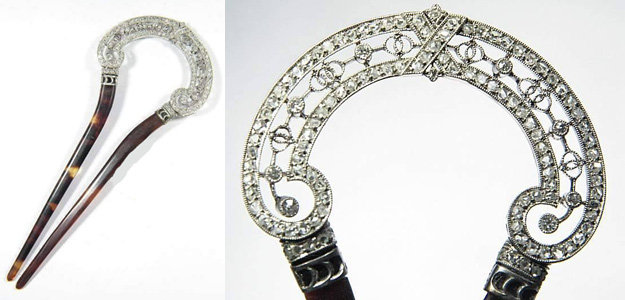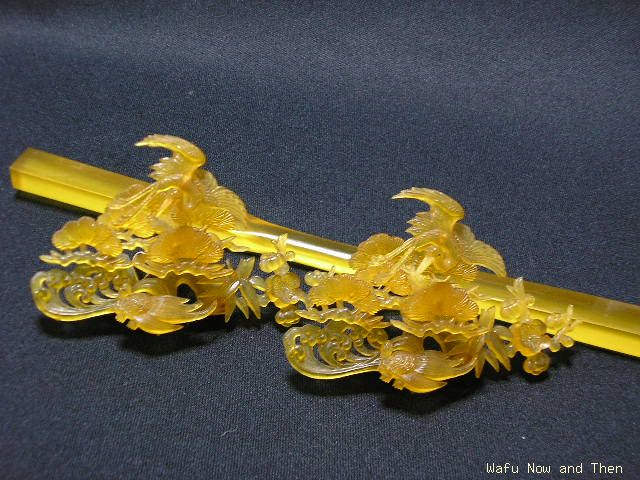I saw it listed at $9.99, 6 days to go. It was a drop-dead gorgeous real shell kanzashi with coral. I thought it was real, anyway. My eyes popped out of my head. I emailed two of my friend collectors. “Are you going for this?” “Do you think it’s real?” The coral is too pink, but it looks real. All of us thought it was real, so I put a large snipe bid on it.
I thought to myself, I could write to this person, ask them to end the auction, play games, but I just am not in that space anymore. The grab, the manipulation of someone who doesn’t know as much as you, the seduction to get the coveted item at a low price.
The whole dance makes me vomit. I couldn’t do it, but I saw this seller’s vulnerability. I mean she was the kind of n00b, who lists a priceless piece and then makes sure people know they don’t get the pillow it’s pictured on as a part of the auction. I am going to value this at around $700. A similar pair of shell kanzashi went for $890 on Trocadero, recently. Comments welcome if you disagree.
In addition to listing it at $9.99 with no reserve, this seller stated she didn’t know what she was doing, that her father left this to her, which means he gave it to her with love, which means it’s real, which means… The (0) next to her name told us it was the first time she was listing on ebay. She was bait for the vultures. I put a snipe bid on it that reflected what I thought was its real value and said nothing.
One day before auction end, the item was gone. Someone wrote to her and convinced her to sell them the item off ebay. I don’t know what they said. I don’t know what kind of value she got. I hope she wasn’t a meal for some dealer, and we don’t see this piece on someone’s site going for full value in the near future. If we do, then I guess we’ll know who the vulture was.
And then the question for all collectors becomes, you either win the game or you don’t. You either get the coveted piece or you don’t. Do you want to do what it takes to win? What will it do to you as a human being? It’s not in me anymore. So ah well, the one that got away.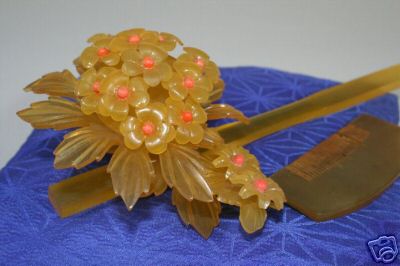
To Delight The Eye
I liked these. :-)
Edo comb, possibly Japanese hibiscus? 18th century.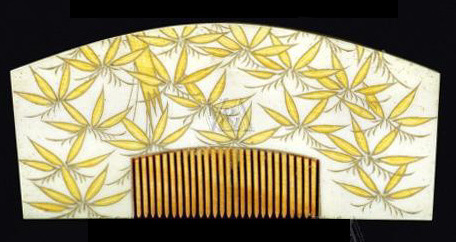
Liturgical comb of Boxwood inlaid with geometric marquetry & studded with silver. Italy, c.1500. The Italians were world renowned for intarsia wood craft during this period, the most famous example being The Gubbio Stuiolo at the Metropolitan Museum of Art.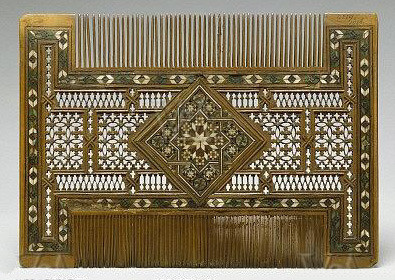
Here is a tiara from Rene Lalique, 1903-1904.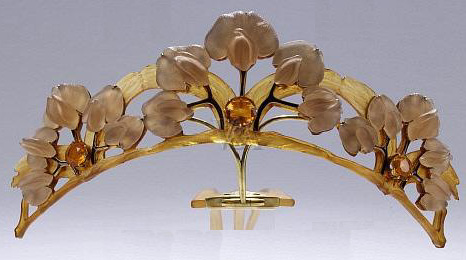
This is a lovely tortoiseshell comb by Alexander Parkes, England. c. 1870.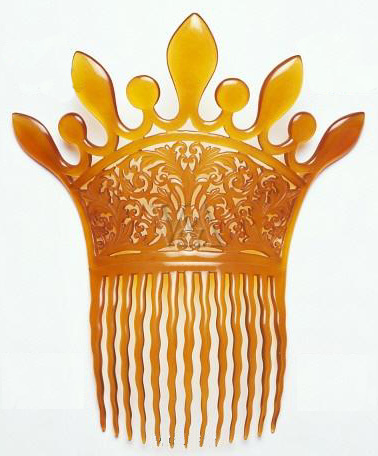
This winged ornament sat atop a tiara, which would be worn to the opera, perhaps a performance of Wagner “Die Walkure” (The Valkyrie). It is made of tortoiseshell, diamonds and pearls. France. c. 1900. 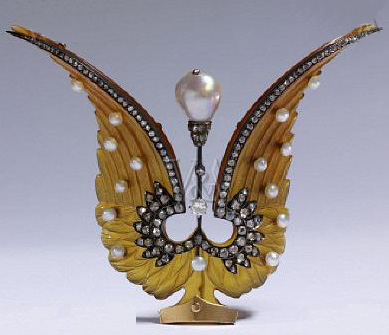
And finally, because I must… ;-) An English rose-cut diamond and pearl tiara, c. 1860. To die for. :-)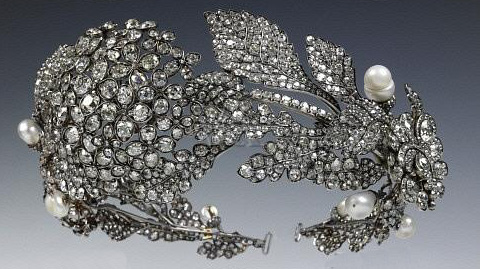
C’est la vie, peeps! Have a great month. :-)
Well, you had to wear them in something
Here are some 19th-century paintings of Geishas in their wigs, wearing the beautiful ornaments we all admire. It’s nice to see kushi and kanzashi in context. From the historical record these paintings provide, it looks like the wigs were just as creative as the combs.
Geisha with Sake Cup, by Keisai Yeisen (1789-1851)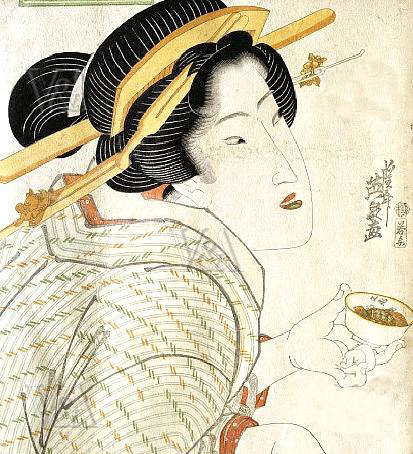
Courtesan with a fan, by Kitagawa Utamaro (1753-1806)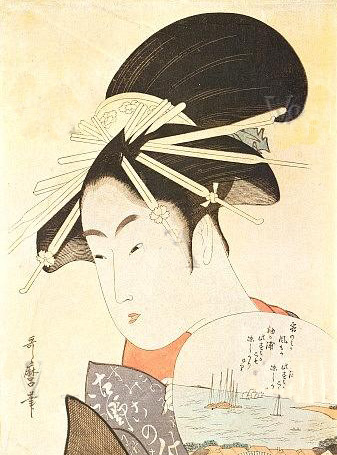
The Doll’s Festival, from the Furyu Goyo Matsu (Five Seasonal Festivals) Series, by Torii Kiyomitsu II (Torii Kiyomine) (1788-1868)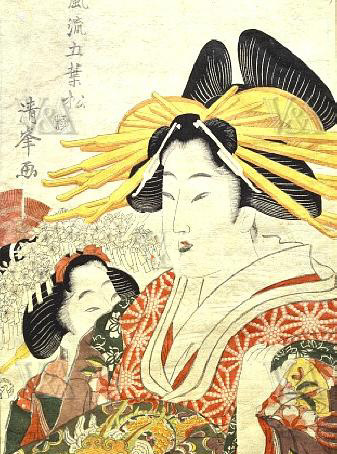
Beauties of the Yoshiwara at Daikoku House, by Keisai Yeisen (1789-1851).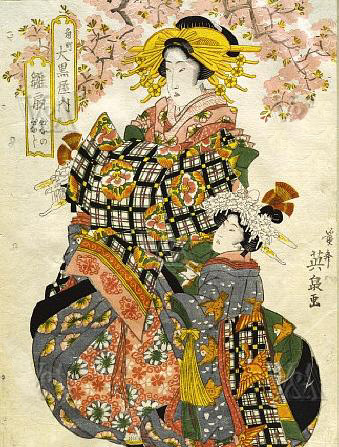
And on a BA-Life Personal Clutz Note: I’m glad my Japanese combs are in a case. Can you imagine balancing in one of those wigs, knowing you have these priceless tortoiseshell ornaments on, and you can’t fall? And the kimonos! Can you imagine walking in that and not falling? Who stopped wearing heels at 40? ;-)
Some Lovely Chinese Kingfisher Pieces
Since I’m on an authenticity kick today, I’ll feature three beautiful antique Chinese kingfisher pieces. One is a tiara and pin set, which sold at an ebay live auction for $250 on May 18. This brass tiara was inlaid with kingfisher feathers, jade, coral and pearls, with minor loss to the feathers and stones. The drop was 2 3/4″, set with small coral beads; and had significant feather loss.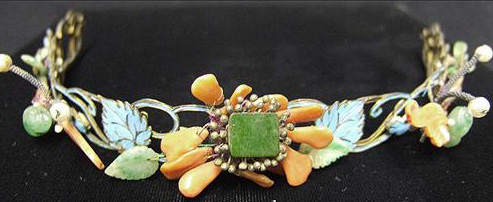


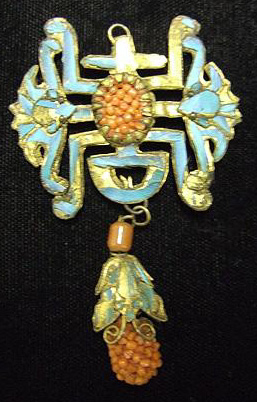
Here is a lovely authentic antique Chinese hair ornament selling on Trocadero for $590. It depicts a still life with jade leaves, rose quartz flowers, and a vase on a metal stand. The ornament also has books and scrolls with Chinese characters written on them, part of a silversmith’s mark stamped on the side (De…), and the kingfisher feathers have come off. The seller dates this to the early 1800s, Qing Dynasty. I don’t know enough to check him. Comments welcome on this, but I have liked this little piece for a long time.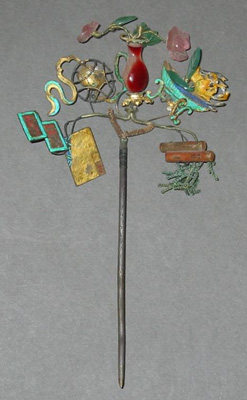
When I see those little Chinese oraments on Ebay, which all look the same, with all the kingfisher feathers in perfect place, for $40, I get suspicious right away. However, the oraments featured here are authentic Chinese antiques. You can see they have ideas in them. The price goes up, the less damage there is to the feathers.
Compare and Contrast
On Ebay recently, there were two interesting auctions that deserve to be compared. The first was for a real tortoiseshell Edo set, consisting of a beautiful comb, blonde with brown markings, and a kanzashi with an attaching ornament of a plover bird on a coral branch. You may refer to my post I Love Japan to see a plover bird kanzashi ornament that belonged to a Japanese prince. The one for sale on ebay was only one little plover bird on one little branch, but who cares. Are we Japanese princes? No. ;-) This set was the real deal.
On May 21, it went on sale for a starting price of $490. For me, that was fine, but $490 is a high starting price for a hair comb on ebay. There is so much going on that amidst the noise, it’s very difficult for a seller to convince our audience that one piece is really worth $490 unless it has a name recognizable to Western buyers, like Tiffany, for example. Also, it’s very difficult to tell the difference between real shell and celluloid from a picture. The set did not sell the first time. It was relisted at at $250 and finally sold for $294 on May 31. Great buy. You may refer to item #190116714443.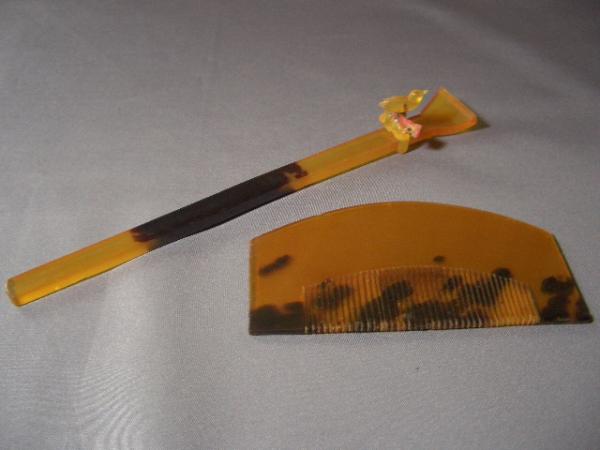
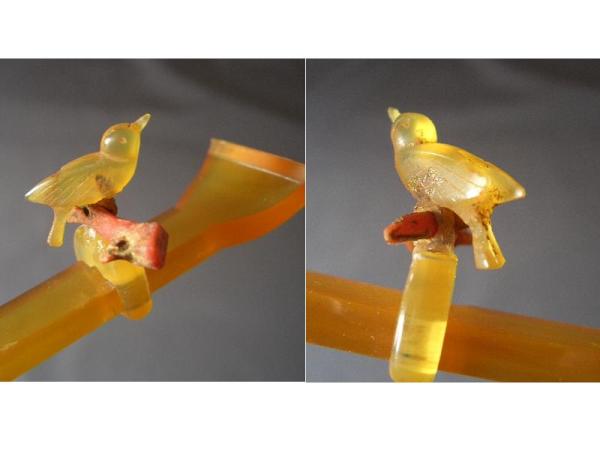
Meanwhile, another seller aquired a Japanese piece from the estate of a geisha. Her great grandchildren told the seller the kanzashi with two ornaments was Taisho and could be tortoiseshell. He repeated the story in his auction. At one point in the auction, the piece was at $522. My eyes widened when I saw this because this piece is one part of a celluloid Japanese wedding set. These sets were sold in Tokyo department stores in the 1940s. If anyone knows that they were made earlier, please let me know in the comments. The entire set goes for around $200 now.
I wrote to the seller. Nice man. My guess: the great grandchildren loved their family member and didn’t know because at one time these sets were made in shell. But the story sold. Amid the noise, the story got the attention of our audience and caused a bidding frenzy that far outweighed the value of the piece. One of the frenzied bidders withdrew, leaving the auction at $9.99, and the piece finally sold for $102.50 on June 7 — within the range of sanity, since it did come from the great grandchildren of the woman who actually wore it. You may refer to Item #120127400313.
For reference, here is an example of a complete imitation shell wedding set.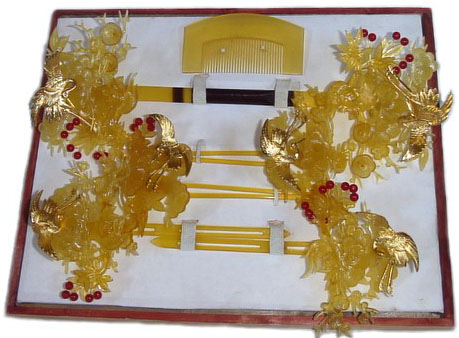
And here is the real thing. Source: a book of a famous Japanese comb collection, which is in a museum.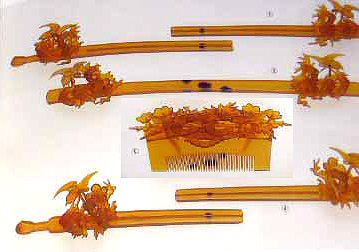
I think the “shell vs. celluloid in a picture” debate will go on forever, but authenticity is perhaps the most important feature of any antique purchase. Know your history, and good luck in your bidding! :-)
Royal Tiaras
I had to do it. :-) Sothebys had an auction of royal tiaras in Switzerland. I chose three tiaras and a coral parure to share with everyone. I can’t pick which one is my favorite.
This emerald and diamond tiara, c. 1870, was formerly the property of a Belgian Princess. The octagonal, step-cut, and hexoganal emeralds at the top weigh 7.58, 7.26 and 8.05 carats, respectively. The two diamonds around the larger center emerald are 2.93 and 3.85 carats, respectively. The tiara is designed as series of bows entwined with foliate sprays. It sold for $341,213.
A German noble family in Westphalia owned this stunning emerald and diamond tiara, c. 1910. It was worn at an official dinner given by Kaiser Wilhelm II by an ancestor of the present owner and sold for $253,555.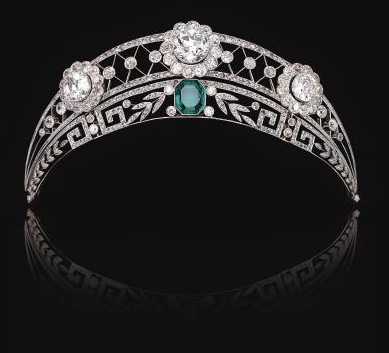
This aquamarine and diamond Belle Epoque tiara was part of the estate of Christian, Lady Hesketh. It has graduated aquamarine clusters interspersed with sprays of diamond myrtle leaves. Sale price: 97,504.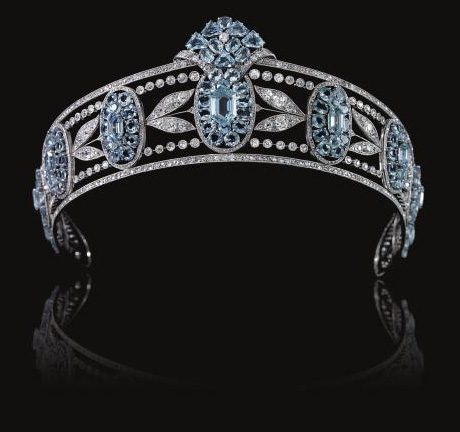
Finally, we have a coral parure, c. 1850. It has the necklace, earrings, pin, bracelet, and in the center is the hair ornament. It could have been worn either as a tiara or a barrette. It sold for $34,938.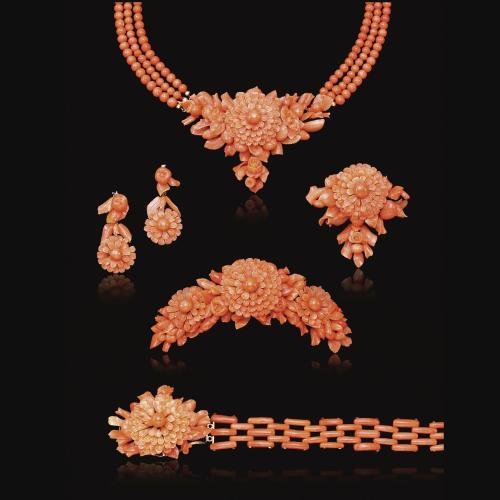
The Mexican Silver Renaissance
As the Mexican Revolution brought social upheaval to the country from 1910 to 1921, Mexicans were struggling not only to bring economic justice to the poor, but to cast off a European cultural identity in favor of an indigenous one. They began to study pre-Columbian folk art, looking to treasures found in archeological ruins for inspiration.
A Tulane University architecture professor named William Spratling went to a sleepy silver-mining town called Taxco and wondered if he could bring it back to life by producing silver jewelry designed with a pre-Columbian aesthetic. His vision worked.
By 1940, he employed over 300 craftsmen, and mentored great silversmith-artists. Hundreds of tallers and artisans opened shops in Taxco to create beautiful silver jewelry. Like every other arts-and-crafts movement in the world, there were also hair combs. :-)
This extremely rare pair of Hubert Harmon Atomic Bomb hair ornaments, in brass, c. 1945, might have been made as a reaction to Hiroshima. They are on sale on Trocadero for $2800.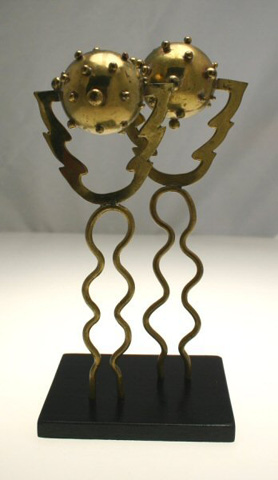
Matilde Poulat, whose designs are distinctly native, opened her shop in 1934. This comb has Aztec motifs, and is also listed on Trocadero, but you have to inquire for a price.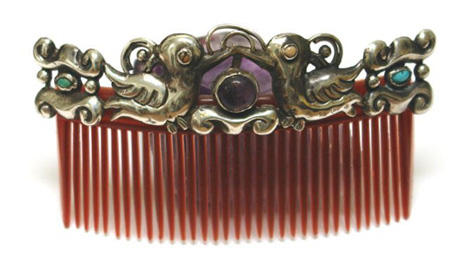
On May 20, this beautiful pair of sterling silver combs by Ana Brilanti went for $224.50 on ebay. She opened her shop, Victoria, in the 1940s and was one of Spratling’s proteges. She even designed a piece for First Lady Eleanor Roosevelt.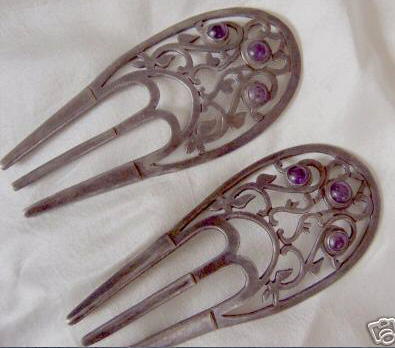
The Great Ivory Comb Debate
Recently, some of us saw a gorgeous ivory comb go on Ruby Lane for $60. It was sold to neatstuffdave, who put it on ebay. I wrote to the original dealer in horror, and told her I thought it was a $600 comb. Dave thought it was worth about $200. It sold to jcollect (a serious collector) for $192, and she knew it was worth more. I was shocked. Here it is: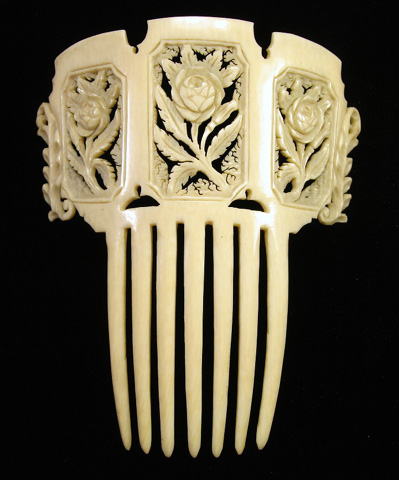
On April 16, a beautiful Chinese ivory comb, probably made for the export market, went for $262.77. It mirrors with peigne Josephine style with the decorative balls on top and combines it with a Chinese theme of two people sitting under a tree. A beautiful comb.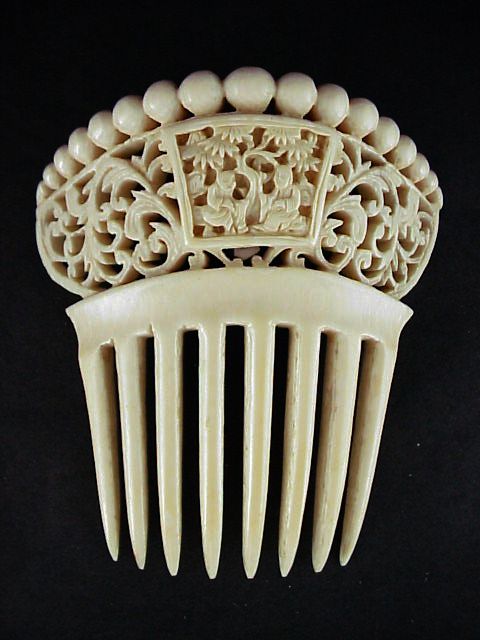
Finally, today, a beautiful peigne Josephine-style ivory comb, drop-dead gorgeous, flawless condition, sold for $743 — the correct valuation in my probably way-too-snobby, obsessed opinion. ;-)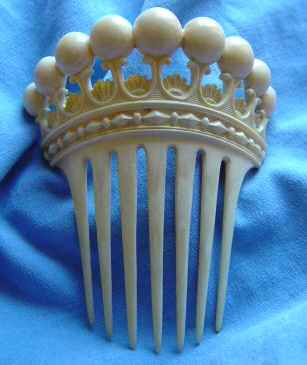
So I have a few questions for the collectors: Was the first one c. 1890, and the one that went for $743 earlier, like c. 1850? Why did the first one go for $192, and this one go for $743? Absolutely no discoloration in the peigne Josephine? Luck of the draw? I’m lost here. Opinions? :-)
The Queen’s Mad Hatter
|
|
|
As I was watching coverage of Queen Elizabeth II’s visit to Jamestown, VA, I couldn’t help marvelling at her glorious, whimsical, colorful, asymmetrical hats. They seem to come right out of Alice in Wonderland. Her milliner is Philip Somerville, of 38 Chiltem Street, London. Here is a small collection.
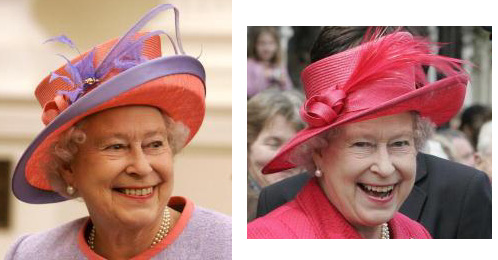
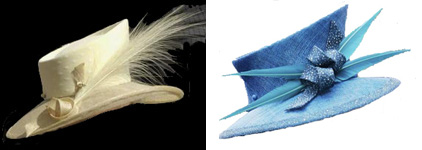

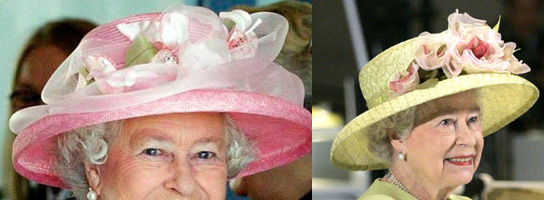
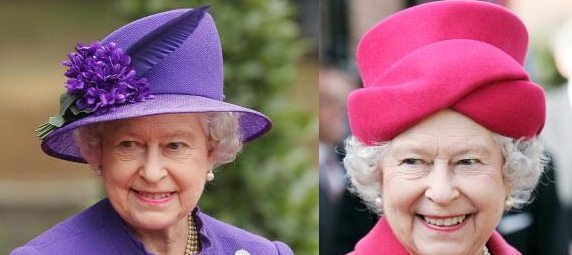
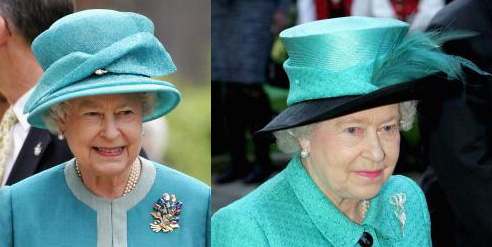
Oh no! She Lost.
A friend of mine was bidding on this. She lost. Oh, that’s tremendously painful. Oh well. Here it is. Beautiful shell, platinum (or 18K white gold) opera comb set with original rose-cut diamonds. c. 1900. It went for $1577.99.